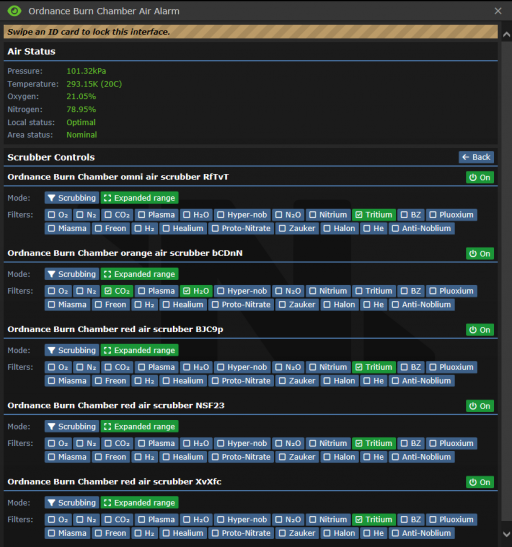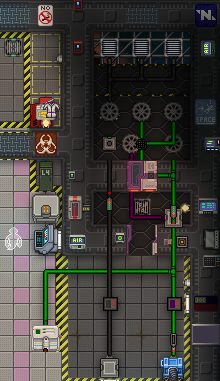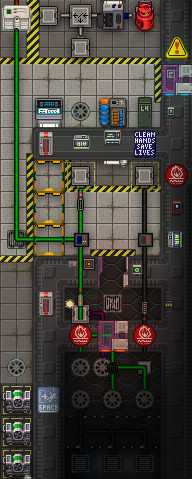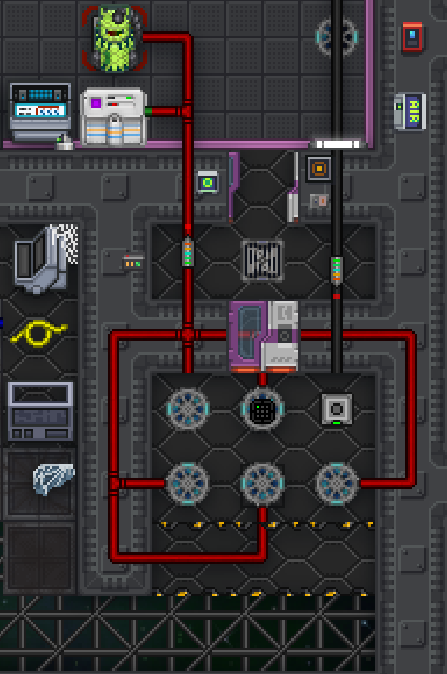Руководство по токсинам
Experiments
There are currently 9 experiments you can complete with help of the toxins lab, which can all be found by downloading the NT frontier app on your tablet or modular computer. Completing any of these experiments rewards you with research points, as well as money for the department funds. The exact amount depends on the tier and partner selected, higher tiers reward more, and some partners will reward more funding, while others will reward more points. Finally, some tech options are heavily discounted when completing certain experiments:
- BZ Gas Shells Provides a 10 000 point discount on Advanced engineering
- Hyper-Noblium Gas shells Provides a 10 000 point discount Quantum Electromagnetic Technology
- Reactionless Explosives Provides a 10 000 point discount on weapon development technology
NT Frontier
NT Frontier is an application found on the purple disk in the ordnance lab, as well as on the software hub. This applicaiton is used to publish papers, see which papers have already been published, and see which experiments are available and what their requirements are. To publish a paper, you first need a data file gathered by either the tank compressor, or tachyon-doppler array. Once you have downloaded a data file from a portable disk, you can use the "publish papers" tab to complete one of the available experiments. First fill out all the empty boxes with a relevant titel, your name, and and optionally an abstract of what you did (or just fill in random nonsense). Next select your data file, and the type and tier of experiment you want to complete, followed by which partner you wish to publish it too. Publishing a paper rewards science with research points, credits for the budget, and any related discounts. The exact reward depends on the type and tier of the experiment, and which partner was chosen.
The Tank Compressor
The tank compressor, found in the toxins launch room, is the device used for Gas Shell type experiments, as well as compressing hot gas into a tank above what the release valve on a canister can achieve. This device has an input port for the gasses that will be compressed into the tank, a slot inside of it for the tank you wish to fill, and an output gas for retrieving any of the gasses inside of the tank at the moment it ruptures. When using the tank compressor for gas shell experiments, you will want to rapidly pump in gas to the tank to the point the tank either starts leaking, or fails dramatically and explodes. In the case of the former happening, the compressor will indicate a LEAK HAZARD and the tank will slowly drain its contents, removal of the tank will make the experiment data availalbe, but removal before it is empty will result in the contents being freed into the room. If the tank explodes, it will simply cease to exist, and the experiment data will become available in the second tab of the machine. When using the machine to compress gas for use in explosive tests, take care not to exceed 2600 kPa, or the tank will become stuck in the machine.
Tachyon-Doppler Array
The Tachyon-Doppler Array records the specifics of any explosion in front of it, spitting out a wall of text as well as producing a data file for use in NT frontier. The array will give the theoretical size of an explosion, which is value used in NT Frontier. The array also notes the possible cause(s) of the explosion, which decides for which experiment the data is eligble.
Other tools of the trade
Items
- Нахождение: Atmospheric technician's locker
- Использование: Cordoning off hull breaches and plasma floods
- Стратегия: Quickly stop local gas floods and prevent hull breaches from sucking all the oxygen out of a room.
This projects holograms that block gases, but let objects pass. Easily your most effective tool to deal with emergencies - quickly seal hull breaches, stop gas floods and fires from spreading or even create a safe cloning/surgery room for Plasmamen.
Creating gasses, ordnance edition
BZ Formation
For both the BZ Gas shell experiment and for the efficient formation of hyper-noblium, you will need BZ Gas. Thankfully, the ordnance lab comes equipped with a freezer chamber suited to do just this. BZ is the product of a reaction between two mol of plasma and one mol of nitrous oxide, this reaction happens fastest at lower pressures. We will modify the freezer chamber to be fed directly by a gas mixer, fed by one plasma canister, and one nitrous oxide canister. The node with the plasma canister should be set 67%, leaving the other node at 33%, the pressure should be maximized. Next, use the unlocked air alarm on the freezer chamber wall to set the scrubber inside of the chamber to scrub BZ at extended range, and turn it on. Lastly, connect a CO2 or Plasma canister to the cooling port on the side off the freezer, and turn on the thermomachine at the lowest temperature. To start the formation, use the computer console, select the freezer chamber, and change the input to 1l/s before turning it on. The plasma/nitrous oxide mixture will now trickle in, slowly forming BZ, connect a canister or small pump to the output to collect your finished BZ.
Tritium
A number of experiments, including all needed to unlock technology, require tritium. Tritium is created by mixing oxygen with plasma at high temperatures, preferably at a ratio of 99:1 oxygen to plasma. To do this, we will use the burn chamber conveniently provided to us in the toxins mixing chamber.
Initial Piping
Leave the input loop (black loop on the bottom left) alone, as it suits our needs for now. Modify the the red (output) loop by adding a cooler to it, you can move a cooler by screwing the panel open and then right clicking it with a wrench, left click rotates the cooler. Next acquire a firesuit, open the outer doors blast doors to expose space, and enter the airlock. Important note: opening the chamber to space and adding this black loop helps efficiency, but you'll take damage because of the cold, drink coffee or skip this step to prevent this. Additionally, make sure to turn off the scrubber on icebox before opening the blast doors, to prevent co2 from entering the loop from outside . Add three additional scrubbers to the red loop. Lastly, add a fourth scrubber facing to space, and connect it to a passive vent in space (Shown in black). This is it for the piping, head back inside.
Use the air alarm next to the burn chamber, and set all scrubbers to extended range. Set the scrubbers connected to the red line to scrub tritium, and turn them all on. Set the black scrubber connected to space to scrub H2O and CO2, and turn it on.
Next, make sure both of the pumps inside of the airlock are set to 4500kPa.
Finally, yell at science for upgrades for the two coolers. Set both coolers to 30 kelvin (43.15 works too if you don't have higher-tier parts), and turn them on.
Tritium production
First, make sure you closed the blast doors, then connect an oxygen canister to the input port and wait untill it is empty, repeat this step two more times untill you have emptied three canisters into the burn chamber. Connect a mini pump to output of the burn mix. Create a tier two canister with 10 metal and 5 plasteel, and wrench this in place on the connector in the airlock (shown in purple). Next, set the input pump back down to 50kPa, and double check your setup, once you are statisfied, connect a plasma tank to the input and hit the igniter on the wall, the plasma will now burn. After several seconds of the chamber heating up, you should see check the output loop with a gas analyzer, and if all goes well you should see it filling up with tritium. Keep an eye on the tank monitor and wait for the mixture to reach around 15 000 kelvin, once this temperature has been reached, turn on the plasma scrubber on the air alarm, and watch the t2 canister fill up with hot plasma. Once your plasma canister reaches around 3500kPA, turn the scrubber back off. Now wait for the rest of the plasma to be converted into tritium, and once it is cooled pump it into small pump, and you should have several hundred moles. If this is not enough, and you have added a loop to dump waste into space, you can simply add more plasma and oxygen as needed. If you do not have a loop to dump waste, open the blast door and vent everything into space, and start anew with three O2 tanks.
Noblium Gas shells
Noblium is a gas created by mixing nitrogen and tritium at under 15 kelvin. This reaction creates a large amount of heat, which can be reduced by adding BZ (BZ will not be consumed if used in this way). Cool down one tank of nitrogen to the same temperature as your tritium (30 kelving if you followed the tritium guide), for ease of mixing. Now clear an area and construct a new loop, Connect this loop to a cooler, add one volume pump with a connector for adding BZ, add one filter that connects to a canister, and pumps the rest back into the loop, lastly add a gas mixer with two connector ports leading into the loop. You will want to configure the filter to remove hyper-noblium, and add a T2 canister to the connector. Next add your BZ canister, and very carefully add around 20-30 mol of BZ into the loop (I recommend setting the pump to 5 l/s or lower). Add your nitrogen to node one on the mixer, and your tritium to node two. Set the mix on the mixer to 66.7% nitrogen, and 33.3% tritium. You only to pump in this mixture untill you have usedaround 50-100 mol of tritium, as that will create enough noblium for the gas shell experiment and leave you with enough to complete nitrium gas shells. Once you are satisfied with the amount of hyper-noblium, cool down your canister, and then transfer all the gas into a small pump and finally into an empty tank to be used in the compressor. Pipe in some random gas to explode the tank, and publish your paper!
Important miscellaneous notes
- Unhooking a tank in a canister that is open will flood the room, doing this with a pump will fill the pump with the surrounding air, this is not good.
- Unwrenching pipes will release the contents, be carefull to empty your pipes before removing them. This does not apply to devices like scrubbers, connectors, and pumps, those can be unwrenched without fear.
- Devices like pumps, filters, and even coolers will hold gasses even if the loops connected to them are empty. To make sure you don't contaminate tanks, especially using coolers, unwrench the scrubber pipe connected to them, rebuild the machine and move them to the right orientation, then rebuild the scrubber.
- Portable air pumps actually pump gas into small portable tanks, allowing you to reach a higher pressure in the tank than in the pump itself, this is the reason its used to fill tanks with cooled gasses. Note however that portable pumps have a low heat tolerance.
- the APC in the test range powers a lot of the mixing lab too, and is disconnected from the powernet by default, yell at engineering to fix this or get an inducer.





